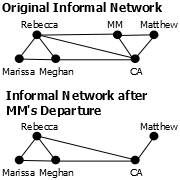My favourite co-worker, a very dear friend, has left the company and will be starting a new job on Monday. This has me thinking about the random-seeming network dynamics that brought us together at CRRC where we began what I hope will be a life-long friendship. It all began with weak ties, very similar to the Old South Network Kadushin (2012, p.80–82) uses to explore strong and weak ties.
I need to start exploring this friendship network by starting with Marissa. Marissa and I became friends while working at Shopper’s Drug Mart while both of us were in school, I for my BEd, and she for Graphic Design at NAIT. She was sent to CRRC for her practicum (a stroke of luck for all of us!). After working there for one year, she discovered that they were looking for part-time layout designers and suggested I apply. I took the job, and after working there for a month, my sister completed her graphics program at NAIT and was not picked up for a job where she completed her practicum. However, by then, CRRC was hiring graphics artists again. We suggested Meghan apply. Our triad of friendship was now a triad of coworkers.
One year later, I decided to start working At CRRC full-time because the life of a substitute teacher was not for me. At this time, they also hired two new full-time layout designers, CA and Shane.
Shane got the job because he knew one of the other layout team members from outside of work. She and Shane, although important to any CRRC network description, aren’t in this network because they aren’t part of the informal friends network.
CA’s story is rather more interesting than Shane’s or mine, and almost prevented us from becoming friends.
CA’s friend’s boyfriend (Matthew) was working at CRRC. He had gained this position because he’d met my manager, MM (not his real initials), in a bar. MM told him to apply to the tech department the next day, and it was through Matthew that CA heard of the job in my department.
At first, I was a little leery of CA. I knew of her connection to MM, whom I didn’t respect for many reasons. My rank-seeking motivation was fulfilled by avoiding associating with MM as much as possible. His weak leadership allowed me to seek out structural holes in the CRRC network and to perform well at my job, surpassing him, and having demonstrated his uselessness as leader, he was removed from the team within a few months of my joining on full-time.
With MM gone, the network rearranged and the shyness between me and CA started to evaporate. We worked closely to each other (propinquity) and discovered that our homophily had more to do with the job: we liked similar books, similar music, similar activities (taking breaks to get coffee or go shopping, for example). Marissa and Mathew were laid off, and because I was always hanging out with Meghan, we became a triad.
Effectance, for us, became about building affiliation. As a team of friends, we were able to get much more work done, and push out the ineffective people, not through workplace politics, but simply by working together to show our own worth. We, at least, demonstrated that effectance is not always about seeking out leaders: it sometimes about becoming them.
Good luck in your new position, CA. I hope that you will find yourself placed centrally on a network where you will be able to find a healthy combination of affiliation and effectance!
References: Kadushin, Charles. (2012). Understanding social networks. New York: Oxford University Press.



Rebecca – nice application of some basic network theory concepts. I also like your sociograms depicting network change overtime. Good work!
Thanks!
Thanks for sharing your practical example with us! I was trying to consider what a map of my office would look like the other day. I would consider us to be a clique, if we were to only map the individuals in the office. However, looking at the specific types of ties between us, there would definitely be some variance in the proximity of the groups. Food for thought!
I’m still struggling with the idea of cliques. I hope to research it more in-depth next week to understand it better. It’s hard to get the communications definition straight when I’ve got the Mean Girls definition stuck in my head!
Pingback: 10 Master Ideas of Social Networks: brought to you by MACT 2013 Cohort! | Tanya's blog about everything